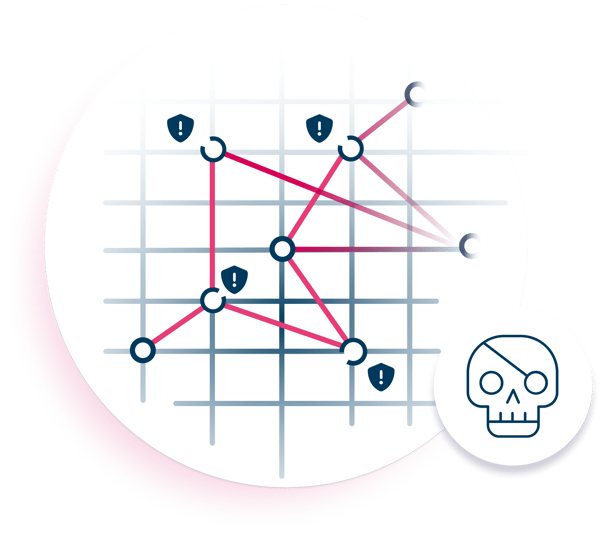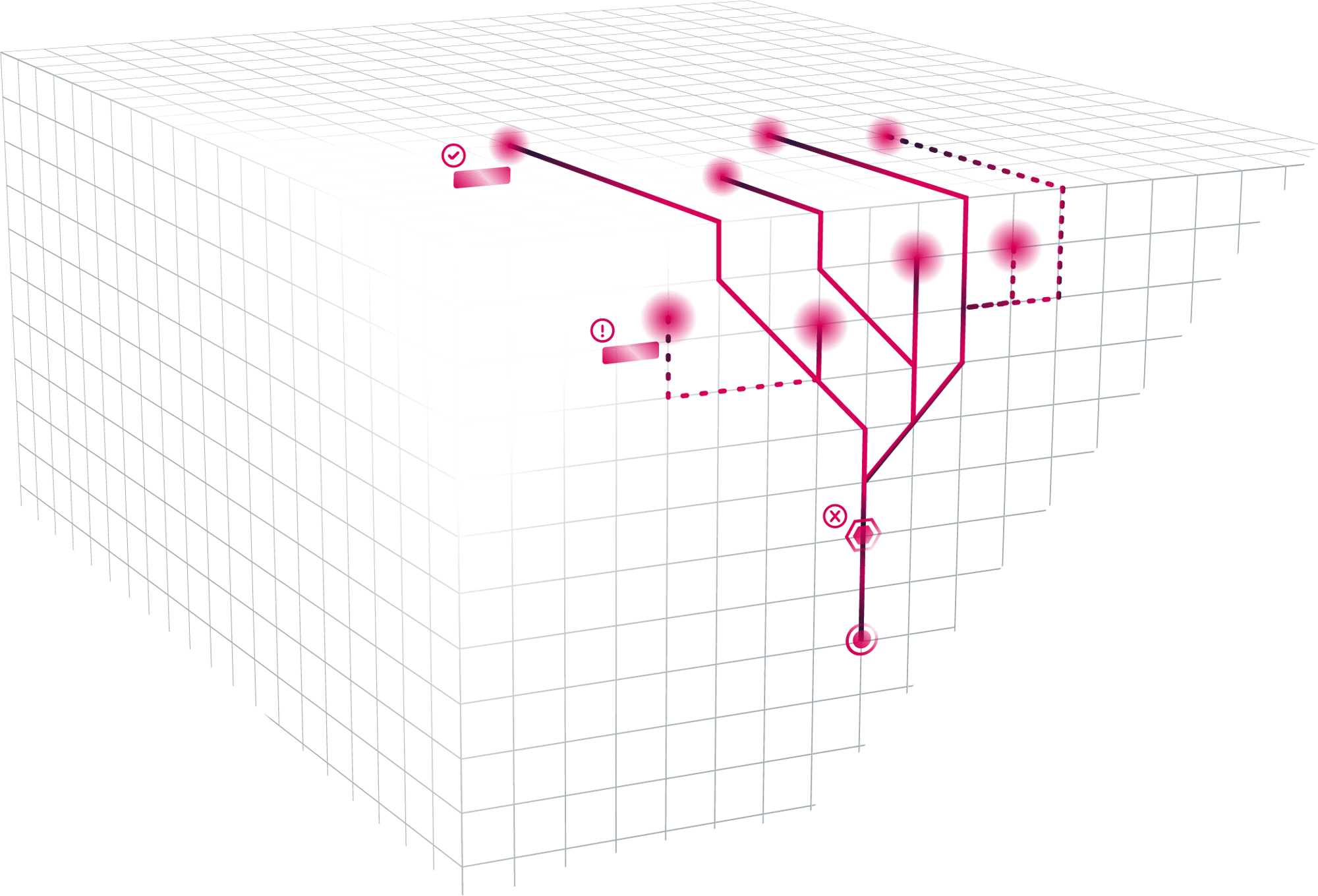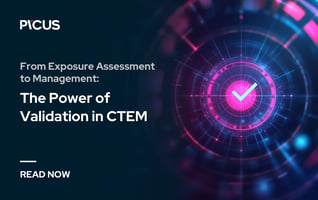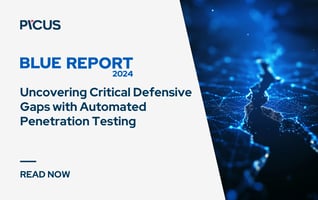Adversarial Exposure Validation
Simulate adversarial attacks to identify exploitable vulnerabilities and prioritize the most critical threats for remediation.

What is Adversarial Exposure Validation?
Adversarial Exposure Validation is a proactive approach to measuring and improving an organization’s security posture. By continuously verifying various threats, such as security vulnerabilities, misconfigurations, and control gaps, AEV identifies exposures that attackers can realistically exploit.
Thus, it helps teams filter out exposures with no business-critical impact and focus on the issues that most significantly reduce overall risk.
Reasons to Validate Your Exposures:
-
Separate theoretical risks from actionable ones
-
Ensure your security controls are prepared for real world attacks
-
Streamline targeted, non-disruptive remediation
Benefits of Adversarial Exposure Validation
By 2026, organizations that prioritize their security investments based on a CTEM program will be three times less likely to suffer a breach.
Gartner, "How to Manage Cybersecurity Threats, Not Episodes", August 21, 2023


More Attack Surface, More Exposure
No longer confined to port and protocol, each connected device or log-in credential is now a potential attacker’s entry point. Migration to the cloud, more remote workers and devices, and a steady stream of new applications offer adversaries many new ways to infiltrate systems.
As you build more complex systems, your attack surface grows too, creating an overwhelming volume of exposures that security teams are incapable of sifting through. At the same time, our time to respond to incidents is shrinking.
Legacy Prioritization Is Not Enough
Scoring vulnerabilities was once a clear way to fix the biggest risk first. CVSS scores and EPSS scores provide rankings but do not consider intelligence from other toolsets or context from critical business units. In addition, many vulnerabilities may be theoretical due to deployed compensating controls, or lack of context.
While vulnerability scoring does provide some prioritization, it does not shorten the length of your team’s to-do list. Essentially, traditional approaches are flawed and fail to consider the organization’s context.


Difficulty in Validating Security Control Effectivenes
Even when vulnerabilities are identified and prioritized, organizations often struggle to validate whether their security controls are effective in mitigating those threats. Many defenses, such as firewalls or endpoint security solutions, may seem sufficient but can fail when faced with real-world attack scenarios.
Without adversarial exposure validation, security teams are left uncertain about whether their current defenses can hold up against actual adversaries and which areas to work on first. This uncertainty increases the risk of undetected, exploitable weaknesses and reduces the effectiveness of remediation efforts.
How to Get Started with AEV
As the leading adversarial exposure validation solution, Picus Security Validation Platform is unmatched in enabling an organization to focus on and remediate the exposures posing the greatest risk.
With leading integrations and existing vulnerability management systems we offer the broadest exposure validation through the use of advanced technologies such as Breach and Attack Simulation, Automated Penetration Testing, and Red Teaming. Our simulation insights and remediation guidance through Picus Mitigation Library empower security teams to take immediateaction against validated exposures.
.png?width=700&height=432&name=How%20Picus%20Helps%20(1).png)

Validate What Matters Most
Discover how to effectively validate and prioritize exposures within the CTEM framework, ensuring your security efforts focus on the most critical threats.

Actionable insights.
Smooth mobilization.
Mobilization is the final stage of an Exposure Management program, where remediation teams are mobilized to address the exposures that have been effectively validated.
Adversarial Exposure Validation technologies are expected to provide ready-to-apply mitigation suggestions from various vendors of your choice, helping to eliminate the potentially disruptive process of manual patching.
By implementing these suggestions, organizations can quickly remove the conditions necessary for an adversary to carry out a successful attack, thereby reducing the operational burden on security teams.
INTEGRATIONS
Unlock Your Security Stack’s Full Power
Picus integrates with your SIEM, EDR, NGFW, WAF, and the rest of security controls to:
- Safely simulate real-world attacks in production
- Reveal gaps each tool misses
-
Fine-tune each control for maximum efficacy

Explore Other Use Cases
How the Picus Platform helps you address your cybersecurity challenges.
Attack
Simulation
Simulate attacks to measure and optimize security controls.
Testing
Stay on top of exposures while alleviating manual testing requirements.
Awarded By The Industry
Customer's Choice
2024 Gartner® Peer Insights™ Voice of the Customer for Breach and Attack Simulation
Cyber Security Excellence Awards
2024 Cybersecurity Excellence Awards – Most Innovative Cybersecurity Company
Customer Reviews
Picus is very good attack simulation tool in overall. It shows all security vulnerabilities and guides..
Sr. Information Security & Risk Officer
The implementation was very fast, the platform is easy to integrate and results quite intuitive to be analyzed.
CIO
It is easy to use and implement the product. It is a really useful tool to find out your security tool vulnerabilities..
Cyber Security Manage
A very successful platform where we can test the accuracy of our security investments and see their scores.
Manager, IT Security and Risk Management
Picus is one of the best BAS solution on the market today. The threat database it is constantly updated..
ICT Security Engineer
Picus completes the task it is required to do near perfect as a BAS solution. Threat database is up to date & updated frequently after a new malware or campaign, also the database is large..
Consultant Security Engineer
There is a very nice team from which I can get quick support. The application provides us with great convenience and confidence in our work.
Information Security Specialist
To test our systems with the real-time attack product is helping us to improve our security maturity. At the same time, the real time attacks are updating with the zero-day vulnerabilities..
Senior Vulnerability Management Engineer
With the help of this product we can perform continuosly endpoint attack via latest tactics and techniques which are used by threat actors..
Manager, IT Security and Risk Management
.. It is possible to customise the campaign or schedule the assessment periodically, to test protection measure implemented on network, endpoint and email.
ICT Security Engineer
Picus is such a great product for organizations that are looking to have constant checks and validation on their security posture in the organization.
Cybersecuirty Pre-sales Engineer.
Picus is a real safety measurement tool. Ever since we took Picus into our inventory, Security has helped significantly to increase our maturity level.
Cyber Defense Senior Specialist
It strengthened our security perspective and allowed us to follow trend attacks. We can test zeroday malicious threats very early because Picus could add them their attack database quickly.
Security Specialist
Latest News and Content About Adversarial Exposure Validation









.png?width=3200&height=323&name=Pattern(1).png)
See the
Picus Security Validation Platform
Request a Demo
Submit a request and we'll share answers to your top security validation and exposure management questions.
Get Threat-ready
Simulate real-world cyber threats in minutes and see a holistic view of your security effectiveness.
Frequently Asked Questions about AEV
Adversarial exposure validation differs from traditional security validation in that it continuously tests the exploitability of identified vulnerabilities in the context of the security measures rather than giving a blank list of exposures. Unlike VM, which assigns & labels through legacy scoring systems like CVSS without proving exploitability, or manual pentesting, which is periodical and resource-intensive, AEV leverages Breach and Attack Simulation, Automated Penetration Testing, and Red Teaming to mimic real-world attacks within an organization’s IT environment. This approach factors in the effectiveness of security controls, pinpointing exploitable vulnerabilities. For instance, a vulnerability rated 9/10 in severity may, through BAS testing, be found to be blocked by a firewall, eliminating unnecessary remediation efforts.
AEV replicates real-world attacks using BAS, Automated Penetration Testing, and Attack Path Mapping (not for assessment but for improved visibility) to simulate adversarial tactics. BAS evaluates network, endpoint, email, and web app security solutions, along with DLP and URL filtering solutions, by simulating downloading attacks of malware, ransomware, RATs, and trojans, running APT kill chain campaigns, and exploiting CVEs (including zero-days) while testing security control effectiveness. Automated Penetration Testing and Attack Path Mapping take an assume-breach approach, starting from any domain-joined account, performing discovery, escalating privileges, and moving laterally to achieve realistic objectives like accessing domain admin accounts. This methodology helps security teams prioritize remediation based on validated, high-risk exposures before actual breaches occur.
AEV can be fully automated through BAS and Automated Penetration Testing in collaboration with Attack Path Mapping. No human intervention is required; however, customization is available for those who prefer manual adjustments. For example, BAS tools, such as Picus SCV, allow users to manually create a full adversary kill chain from a selected threat blog of their choice, tailoring simulations to specific attack scenarios.
AEV tools offer extensive integration capabilities for BAS and Automated Penetration Testing in collaboration with Attack Path Mapping. BAS seamlessly integrates with and evaluates a wide range of security solutions, including NGFW, WAF, IPS, SEG, SWG, DLP, URL Filtering, IDS, EDR, XDR, AV, Vulnerability Assessment tools, and SIEM, ensuring that both preventive and detective layers are properly configured to mitigate threats before they escalate. Additionally, Automated Penetration Testing solutions simulate sophisticated adversaries within the Windows AD environment, identifying critical attack paths leading to domain admin accounts or enabling ransomware deployment across the domain.
Zero-day testing is one of the most valuable use cases of BAS. If a publicly available and validated proof of concept (PoC) exists for a particular zero-day vulnerability, Picus Labs' Red Team engineers create a ready-to-run attack template within a 24-hour SLA in Picus Security Control Validation. Common vulnerabilities are also cataloged in the Picus Threat Template, ensuring comprehensive coverage. Additionally, security weaknesses within directory environments in customer domains are addressed through Automated Penetration Testing, such as Picus Attack Path Validation, which identifies and maps exploitable attack paths.
AEV should be an ongoing practice rather than a one-time process. Organizational environments are constantly evolving, with new workstations and user accounts being added or removed, and updates or configuration changes affecting security controls. Preventive solutions, such as firewalls, need continuous validation to ensure they are active and effectively blocking attacks, while detection solutions must be monitored to confirm that threats are properly logged and alerted. Given these dynamic factors, security teams require continuous visibility to proactively identify and address emerging vulnerabilities, ensuring their defenses remain effective against evolving threats.
Organizations can implement Adversarial Exposure Validation (AEV) by integrating continuous attack simulations into their security strategy. This requires a strong foundation in vulnerability management, attack surface visibility, and risk assessment. AEV tools, such as Breach and Attack Simulation (BAS), Automated Penetration Testing, and Red Teaming, validate exposures by mimicking real-world attack tactics.
Prerequisites include a well-defined security framework and integration with prevention solutions like NGFW, WAF, IPS, Secure Web Gateway (SWG), and Secure Email Gateway (SEG), as well as endpoint detection, prevention, and alerting systems such as SIEM, IDS, EDR, XDR, EPP, and DLP for BAS assessments. Additionally, integration with directory services like Active Directory (AD) is essential for advanced automated penetration testing. Effective collaboration among security, IT, and compliance teams is also critical.
By prioritizing actionable threats and refining defense mechanisms, AEV enhances security posture, minimizes false positives, and ensures a proactive, threat-driven approach to cyber risk management.
Adversarial Exposure Validation verifies that exploitable security vulnerabiltiies and active threats are effectively mitigated by your security controls—essential for compliance. For example, GDPR requires technical and organizational measures (Article 32) and regular testing to protect personal data. AEV provides tangible evidence that controls like firewalls, EDR, and SIEM are effective. Similarly, ISO 27001 demands ongoing risk-based monitoring and testing, while NIST emphasizes continuous assessment. Furthermore, DORA mandates comprehensive testing to ensure digital resilience. To see the exact articles that AEV covers, read this whitepaper, or visit this website for a quick overview. In short, AEV strengthens security posture and supplies documented, evidence-based proof necessary to meet compliance standards across multiple regulatory frameworks, ensuring robust, continuous cybersecurity assurance globally.

